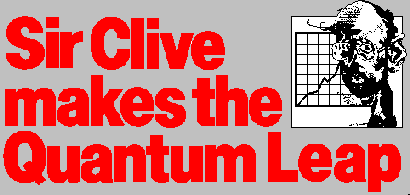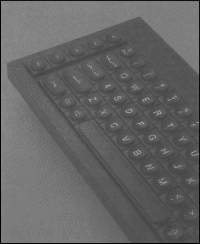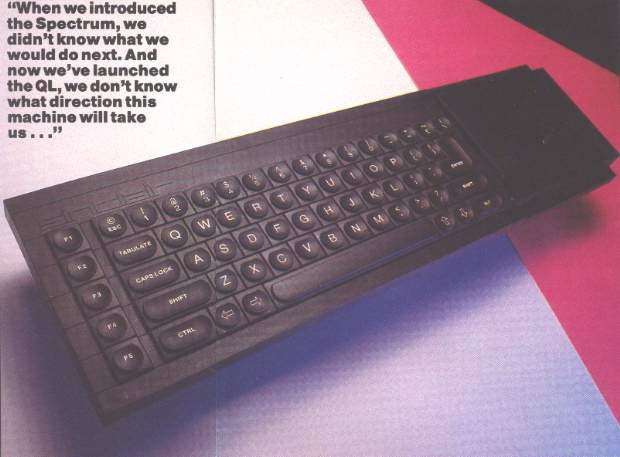
Leapfrogging the opposition, Sir Clive's new micro looks set to crack the business computer market wide open. Innovative, stylish and powerful - and that was just the press conference! Sue Denham was there to bring you a blow-by-blow account of the excitement as Sinclair Research ceremonially unveiled its latest creation. | |
|---|---|
|
Amidst a Hollywood-style 'turning
'em away' launch at the
Intercontinental Hotel on January
12th, the world's technical press
gathered en masse to see their
favourite 'Mr Success' unveil his
latest creation. To the whirring of
video cameras and the clicking of
cameras, Sir Clive with MD Nigel
Searle took to the stage to announce
the coming of the Sinclair QL. As most must now know, the initials QL stand (modestly) for Quantum Leap and, as if to drive home the point, Searle emphasised that the new device was in no way a competitor to the ZX Spectrum. Described as a "business machine, but not in the traditional sense", the QL is being pitched towards the advanced home user, the professional and the university student. And priced as it is at £399, the QL could very easily do for the business market what the ZX81 and Spectrum did for home computing. As might be expected from a development project that lasted nigh on 14 months and ate into the best part of £2 million, the QL is tastefully designed with the word 'Sinclair' moulded into the top - a good start towards guaranteeing success in the market. The unit itself measures in at a handy 138mm by 46mm by 472mm 
|
and tips the scales at 1388 grams (or
just over 3lbs for those of you who
have managed to resist going
decimal). Built into the unit is a full
QWERTY keyboard with 65 keys,
including a space-bar, five function
keys and four separate cursor control
keys. And for those preferring to work
with an angled keyboard, the entire
device can be tilted using detachable
feet.
IT'S THE BUSINESSMoving to the inside, the QL contains two processors and two custom-built chips. All the main processing is achieved with a 68008, the 32-bit microprocessor so highly favoured by more expensive computers. Alongside this is an Intel 8049, used to control such mundane tasks as the keyboard, sound and RS232C receiver functions. The two custom chips were designed by Sinclair Research; one takes charge of the display and memory, and the other controls the Microdrives, the real-time clock, the local area network (LAN) and the RS232C transmission.As far as memory is concerned, Sinclair Research's new machine delivers the goods with 128K of internal RAM. And if that's not enough for you, a RAM expansion board will be available to expand this up to 640K. The QL's 32K ROM contains a single-user, multi-tasking, time-sliced operating system called QDOS, which has been custom designed for the new machine and makes full use of the command language, Sinclair SuperBasic. And while on the subject of SuperBasic, Nigel Searle asserted that, "It puts right all the things wrong with Basic. Indeed, it's so different |

|
with your annual subscription of £35
will entitle you lucky members to six
newsletters and one free update to
each of the four Psion software
packages.
JOKING APARTDespite the importance of the occasion, Sir Clive was unable to resist drawing the inevitable comparisons between the QL and various micros already available on the market. With a wistful smile, he happily announced that to get an equivalent machine using the BBC 'B' as a base you would have to spend £1,800; for the Apple IIe - £2,150; for the ACT Apricot - £2,270; and for the IBM PC - £2,670. Even though Sir Clive himself proclaimed the exercise to be virtually meaningless, he went on to say that Commodore's new computer would be "miles away" from the QL and Apple's Macintosh would be "less performance at four times the price".It will come as no surprise to the dedicated Sinclophile that the QL will be available to begin with as a mail order item only. Priced at £399, you'll have to include a further £7.95 to cover postage and packing, and deliveries are promised within 28 days of the receipt of the order. Those eager to join the queue or make further enquiries should either phone nnnn nnnnnn or write to Sinclair Research Ltd at FREEPOST, xxxxxxxxx, xxxxxx xxnn nxx. High street retail outlets will be used to market the QL later in the year, and support for this is expected from the manufacturers of the machine, Thorn- EMI, who expect to be ramping up their production to 20,000 units by the summer of this year. When asked about the future involvement of Sinclair Research in the micro field, Sir Clive proclaimed, "When we introduced the Spectrum, we didn't know what we would do next. And now we've launched the QL, we don't know in what direction this machine will take us ...". All you can be sure of is that wherever Sinclair Research goes, a very large after- market of assorted suppliers is bound to follow. | |
|
that it's deserving of a new name".
However, it still includes the 'Basic'
tag, if only to prevent users being put
off at the thought of having to get to
grips with a new language. But that
said, it's claimed that anyone
proficient in Sinclair Basic should
have no problem finding their way
round SuperBasic; and the fact that
the new language is fully procedure
structured, extendable, and its
execution speed is independent of
program size, certainly seems to make
the effort worthwhile. Although it was rumoured that the QL would contain 3¼-inch floppy disks, Sir Clive in fact has plumped for an upgraded ZX Microdrive as the means of creating extra storage for the device. The QL Microdrives are not compatible with their forebears, and have increased capacity (to 100K) and a faster data transfer rate than their ZX counterparts. The QL contains two such devices internally, with the option of connecting a further six. The QL also has a slot to accept a QL ROM cartridge (again not compatible with the Spectrum equivalent) which, as time goes by, will no doubt offer access for programs written for the machine. |
An array of ports can be seen at the
back of the device and these include
two joystick ports, two RS232C
interfaces (allowing modems and
professional printers to be added), a
TV port, and a monitor port which
provides two modes of resolution: 512
by 256 pixels and 256 by 256 pixels.
There's also a high-speed
communication link called QLAN,
which can cater for up to 64 QL and
Spectrum micros - passing data over
the network at a rate of 100K baud. Any comments you may have at this stage as regards options missing from the QL package may well have been foreseen by Sinclair Research. Enhancements already under development by the company for the QL include a C compiler, a 68000 assembler, a terminal emulator, an A/D convertor, a hard disk interface, a modem, a parallel printer interface and an IEEE-488 interface. And in addition to this impressive list, Nigel Searle announced that, "There are plans for a professional printer", and also that, "there will certainly be a version of Prolog for the QL". THE SOFT OPTIONBacking up the machine with suitable software is a problem that's been |
taken quite seriously and Sinclair
Research - together with Psion -
produced four software packages to
accompany the QL package, all
inclusive within the asking price.
Developed over 18 months, the
software covers the areas of
word processing, spreadsheets,
database management and business
graphics. These are traditional
business packages and as David
Potter (managing director of Psion
Ltd) demonstrated, the packages are
extremely versatile and easy to use.
Indeed, Nigel Searle commented that
"in just three minutes, the first-time
user would be able to use these
packages". It's claimed in the
accompanying literature that as the
suite of programs was designed as an
integrated package, learn the ins and
outs of one and you'll learn them all! The QL package is accompanied by a manual of massive proportions that contains a description of the machine, a guide to Sinclair SuperBasic, a SuperBasic reference manual and an examination of the four Psion software packages. For further back-up, Sinclair Research has formed the QL Users Bureau (QLUB - geddit!). Parting |